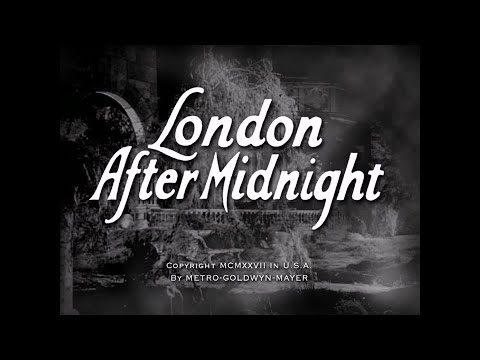London After Midnight (1927): The Lost Lon Chaney Horror Classic
The Most Famous Lost Horror Film
Few lost movies command the same fascination as London After Midnight (1927). Directed by Tod Browning and starring Lon Chaney, the silent-era mystery-horror hybrid is remembered for its haunting visuals, infamous “Man in the Beaver Hat” makeup, and its tragic disappearance in the 1965 MGM vault fire [6]. Today, it stands as one of cinema’s great “holy grails,” inspiring reconstructions, scholarship, and pop culture tributes nearly a century after its release.
Conception and MGM Production
London After Midnight was adapted from Browning’s earlier story, The Hypnotist, with a scenario by Waldemar Young and intertitles by Joseph W. Farnham [1]. The moody cinematography came from Merritt B. Gerstad, while the gothic set design was the work of Cedric Gibbons and Arnold Gillespie [1].
The cast included:
- Lon Chaney in a dual role as Inspector Burke and the mysterious Man in the Beaver Hat
- Marceline Day as Lucille Balfour
- Conrad Nagel as Arthur Hibbs
- Henry B. Walthall as Sir James Hamlin
- Polly Moran, Edna Tichenor, and Claude King in supporting roles [1].
The film’s budget was roughly $151,666, and it earned over $1 million in worldwide rentals—making it a major financial success for MGM [1].
Plot Summary: A Mystery in the Shadows
Set in 1920s London, the story begins with the death of Sir Roger Balfour from an apparent suicide. Inspector Edward C. Burke (Chaney) closes the case, but doubts remain for Sir James Hamlin [1].
Five years later, eerie sightings at the abandoned Balfour mansion draw Burke back. Two strange figures—a ghoulish man in a towering hat and a silent “Bat Girl”—haunt the estate. Scenes of midnight grave exhumations, ghostly visions, and mounting dread suggest supernatural forces at play.
The twist: under hypnosis, Sir James confesses to murdering Balfour to secure a marriage to his daughter. The phantoms were part of Burke’s elaborate sting to reveal the truth [1].
The Iconic Makeup of Lon Chaney
Chaney’s transformation into the Man in the Beaver Hat remains one of silent cinema’s most striking images. Using wires to widen his eyes, sharpened false teeth, stark white greasepaint, and an exaggerated wig beneath an oversized hat, Chaney crafted a look both grotesque and hypnotic [2]. The self-applied design became a blueprint for psychological horror in film.
Critical Reception in 1927
When London After Midnight premiered in December 1927, reviews were mixed.
- The New York Times praised its eerie visuals but criticized the plot’s plausibility [5].
- Variety called the story “thin” but admitted the film had unusual charm [5].
Despite the divided critical response, audiences embraced the film, and its box-office success strengthened Browning’s partnership with MGM [1].
A Lost Film After the 1965 MGM Vault Fire
The only known print of London After Midnight was destroyed in the August 10, 1965 MGM vault fire [6], sealing its fate as one of the most famous lost films in history.
Preservation Efforts and Reconstructions
1928 – London After Midnight novelization by Marie Coolidge-Rask [7].
1985 – Film historian Philip J. Riley reconstructs the film from stills and script [8].
2002 – Turner Classic Movies releases a 45-minute photo reconstruction by Rick Schmidlin [9].
2022 – Researcher Daniel Titley uncovers nitrate fragments and production details [10].
2023 – Full-cast audio drama adaptation released on Bandcamp and Midnight Matinees [11].
Cultural Legacy and Influence
Even without surviving footage, London After Midnight has influenced film and popular culture:
Early Vampire Archetype? – Some film historians consider the Man in the Beaver Hat a proto-vampire in U.S. cinema [12].
Influence on Modern Films – Director Jennifer Kent of The Babadook has cited awareness of Chaney’s imagery [13].
Television Homage – The British crime drama Whitechapel included a plot involving a killer obsessed with the film [14].
Record-Breaking Memorabilia – In 2014, an original poster sold for $478,000 to Metallica’s Kirk Hammett, now on display at the Royal Ontario Museum [15].
Why It Still Haunts Audiences Today
Three enduring elements keep London After Midnight alive in horror history:
- Lon Chaney’s Mastery of Makeup – A transformation that still shocks with its intensity.
- Browning’s Twist Ending – A revelation that the horror was human, not supernatural.
- The Allure of the Lost Film – With no surviving footage, it thrives in imagination and legend.
We may never see London After Midnight exactly as 1927 audiences did, but its shadow continues to loom over horror cinema. From reconstructions to cultural references, the film proves that sometimes the most terrifying stories are the ones we can only picture in our minds.
References
[1] Wikipedia – London After Midnight (film)
[2] Skal, David J. The Monster Show: A Cultural History of Horror. Faber & Faber, 1993.
[3] Vieira, Mark A. Sin in Soft Focus: Pre-Code Hollywood. Harry N. Abrams, 1999.
[4] Riley, Philip J. London After Midnight. MagicImage Filmbooks, 1985.
[5] The New York Times archives (Dec. 1927), Variety archives (Dec. 1927).
[6] Wikipedia – 1965 MGM vault fire
[7] Coolidge-Rask, Marie. London After Midnight (novelization), 1928.
[8] Riley, Philip J., ed. 1985 Reconstruction notes.
[9] Turner Classic Movies – Rick Schmidlin reconstruction, 2002.
[10] Titley, Daniel. Research presentation, 2022 Silent Film Conference.
[11] Midnight Matinees podcast, Bandcamp release, 2023.
[12] Skal, David J., op. cit.
[13] Interview with Jennifer Kent, The Guardian, 2014.
[14] ITV series Whitechapel, Season 3, Episodes 5–6.
[15] Heritage Auctions press release, 2014.




Add Comment